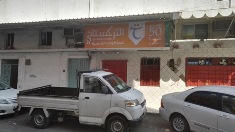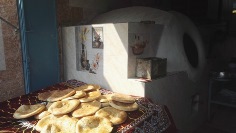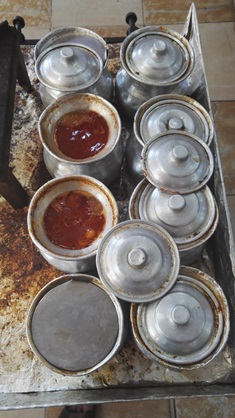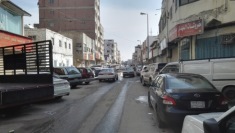Magnus Marsden reports
Notes from the field: Jeddah, Kingdom of Saudi Arabia, 27/11/16-17/12/16
It seems like a long time since I bumped into two traders in their mid-forties from Afghanistan on a cold and wet spring night in Yiwu’s night market. As I chatted to them I assumed they had come to the city from Afghanistan, mostly likely Mazar-e Sharif, in order to ship one or other ‘small commodity’ for wholesale in their region. I was surprised however when they told me that they had visited the city from Saudi Arabia, where they were based in the great Red Sea port city of Jeddah. After chatting about the political dynamics of northern Afghanistan, they gave me their business cards before heading back to their hotel. For the remainder of my time in Yiwu I often enquired about the Afghan community in Saudi Arabia and their ties to China in general and Yiwu in particular. I was told about a street in Jeddah called Bukharia – the Arabic version of ‘Bukhara’, the Central Asian Emirate. A relatively elderly Afghan trader based in Yiwu told me that he had stayed in Jeddah as a young man for several years in the 1970s, and been employed by a Turkmen-speaking man from Afghanistan who owned a restaurant and also imported spare parts to Saudi Arabia from Japan and South Korea. While gleaming insights about the Afghan community in Saudi Arabia and Jeddah in particular through conversations with such people, I doubted whether I would eventually make it to see the Bukharia street. Rather abruptly, however, I heard in October that I was to be appointed a Visiting Fellow at the King Faisal Research and Islamic Studies Centre in Riyadh, and that this appointment would allow me to visit Jeddah.
The trip to Jeddah, my last spell of field research in this phase of the project, was well worth the wait. When the project commenced I had not anticipated that it would take me to Saudi Arabia, and, indeed, had very little idea of what to expect of the country. Within two hours of landing in Jeddah, I had already bumped into the men I had met on that spring night in Yiwu: now dressed in Arab robes, they showed me the shops in the historic Bab Sharif part of the city in which they sold trainers that had been imported from Guangzhou and Yiwu. A little further on from Bab Sharif, not far from the Bab Mecca or Meccan Gate, I walked into a modern market complex with wholesale shops selling ready-made clothes of the type that are readily available in Yiwu’s Huangyuang clothing market. Clothing for sale include t-shirts, dresses aimed at Middle Eastern markets, and nightwear. Wandering down one of the corridors I was beckoned into a shop by a man in his thirties. It took me a few seconds to recognise him as having stayed in the same Istanbul hotel as I had earlier in the summer. In the days that followed I had many such meetings and encounters with traders I had met in both China and Turkey. Some had also been in Ukraine in 2016, underscoring the interconnected nature of these traders’ lives and the contexts across which they moved.
During my conversations with these people, I was able to get a sense of their family backgrounds in Afghanistan, the ways in which they had moved from Afghanistan and then Pakistan to Saudi Arabia, their modes of making a living, as well as their relations with other communities (such as Yemenis) also present in the city. It was also fascinating to hear older members of the community talk about how they had initially travelled by road from Afghanistan to Mecca in the early 1970s, making some money on the way by selling Indian-made jewellery in Iran as well as Afghan carpets to Yemenis in Mecca, and, on the return, by selling Kuwaiti abbayas to Iranians. And they also had much to see about the changing nature of the neighbourhood in which they lived, as well as their relations with earlier waves of Central Asian emigres in the city.
A focal point of my stay of course was repeated visits to the ‘Bukharia street’, about which I had been told so much in Yiwu. The Bukharia street is actually a neighbourhood that comprises two streets. The neighbourhood’s narrow alleys are bustling with activity, as children run around, and men make their way to and from the many mosques and the local bakery. The shops on both of the main streets that run through the area are largely staffed by people from northern Afghanistan, especially Uzbeks and Turkmens, but also some Dari-speaking Tajiks from eastern and northern Afghanistan. The businesses on one of the streets are predominantly related to the restaurant trade, a sector of the Saudi Arabian economy within which people from Afghanistan, especially the northern region of Sar-i Pul, are very active. In this street, Afghans sell the type of large aluminium cooking pot in which the region’s famous rice dish – palao – is cooked; these pots are themselves made by the Afghan community who benefit from living in the cool air and mountain landscape of the nearby city of Taif. I was also told that the business in these shops had seen an upturn recently as the craftsmen there had also begun fitting Saudi Arabian kitchens with the appliances needed to cook local food, such as the type of ovens used to cook the Yemeni dish, mandi.
The businesses on the other street in the Bukharia are largely centred around the sale of carpets, prayer mats, blankets, and furniture, which, are either imported from China or from Turkey. A couple of shops also sell handwoven carpets from Afghanistan, Iran, China, Pakistan and the Caucasus. Spending time in these shops allowed me to meet young men who had spent much of their adult lives in Chinese cities (Yiwu and Guangzhou), and were able to speak in addition to Persian and Arabic fluent Cantonese or Mandarin.
There is also a thriving trade in dried fruits – for long a speciality of Afghan merchants – in Bukharia and one day as I was wondering along the commercial street a number of delivery vans arrived carrying boxes of raisins stamped ‘Product of Afghanistan’. Nevertheless, the poor state of Saudi Arabia-Iran relations has meant that traders who used to bring goods such as saffron and pistachio nuts from Iran have had to find new sources or alternatively use alternative routes. Instability in Iraq and war in Syria also make importing goods from Afghanistan to Saudi Arabia perilous.
There have been Central Asians living in this neighbourhood since the 1930s. While individual Central Asians had been based in the city having stayed there after having made the haj pilgrimage, the first significant migration comprised people from parts of Central Asia that were incorporated into the USSR. These early group of emigres were given Saudi Arabian citizenship and having initially run restaurants and bakeries eventually became well established in Jeddah and the Kingdom of Saudi Arabia more generally. My present-day Afghan informants told me that they maintained relations with such families, and had, until a decade or so previously, interacted with them frequently. Now, however, I was told, these initial Bukharan emigres have moved to more comfortable parts of the city (as wealthier Afghans are also doing) and so the communities are less closely in contact with one another. Nevertheless, many of the shops in which Afghans work, as well as the homes they rent, are owned by ‘original’ Bukharan emigres.
It would be inappropriate to not mention the enormous importance of food and sociality to the everyday life of the Afghan community in Jeddah, not least because besides the shops in which Afghans work, cheap eateries were one of the most successful places in the city for conducting fieldwork. As I mentioned above, there is a clear and visible presence of Afghans in the restaurant business in Saudi Arabia – almost all inexpensive eateries selling Ruz Bukhari (Bukharan rice) are staffed by men and boys from Sar-i Pul: this Central Asia dish, altered over the course of many years to suit Arab tastes, is one of the most popular across the Kingdom. There is a difference however between such venues and those tucked away in the child-thronged backstreets of the Bukharia neighbourhood in which it is possible to eat authentically ‘heavy’ food from northern Afghanistan: plates full of skewered kebabs, vessels of steaming cow foot stew (pacha), and enormous mounds of rice cooked with plenty of oil, meat, carrots and raisins. Eating such food while sitting cross-legged on raised wooden platforms and watching the news about the homeland with men who had often not visited it for thirty to forty years on Afghan channels filled a considerable part of my day in Jeddah, especially during the spell between midday and afternoon prayers, and the end of the day when Afghans close their shop shutters at 11pm. This form of sociality was also perfectly suited to my fieldwork. Diners are these restaurants were delighted to talk to the visiting anthropologist who spoke Farsi and had been to their country, a country that most of the younger men and boys in Jeddah have never seen, and were eager to hear my opinions about. These restaurants also provided the opportunity to meet Afghans visiting Jeddah from the two cities in the Kingdom that are home to substantial communities of Afghans but that non-Muslims are prohibited from visiting: Mecca and Madina. All too often, though, my fellow diners embarrassed me with their unreturnable hospitality and generosity. Finally, as many of the eateries aimed at Afghan clients were small family affairs where the food is cooked by fathers and served by sons, I was also able to get a sense of some of the generational dynamics as well as the aspirations that fathers have for their children.
My first but hopefully not last visit to Saudi Arabia was capped off by being hosted in the home of a Turkmen family in Riyadh who invited several friends and family members to meet me, discuss my research, share food and tea, and relax to the sound of their friends playing the Afghan damboora and sing songs in a mixture of Turkmen, Uzbek, Farsi and Pashto.
Jeddah





